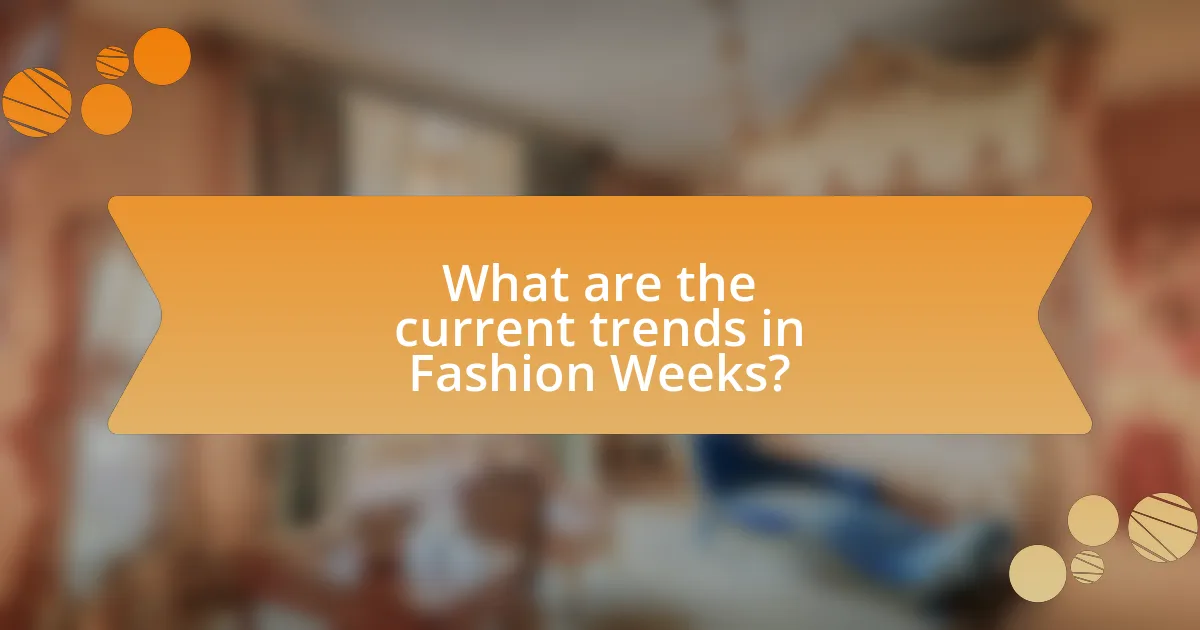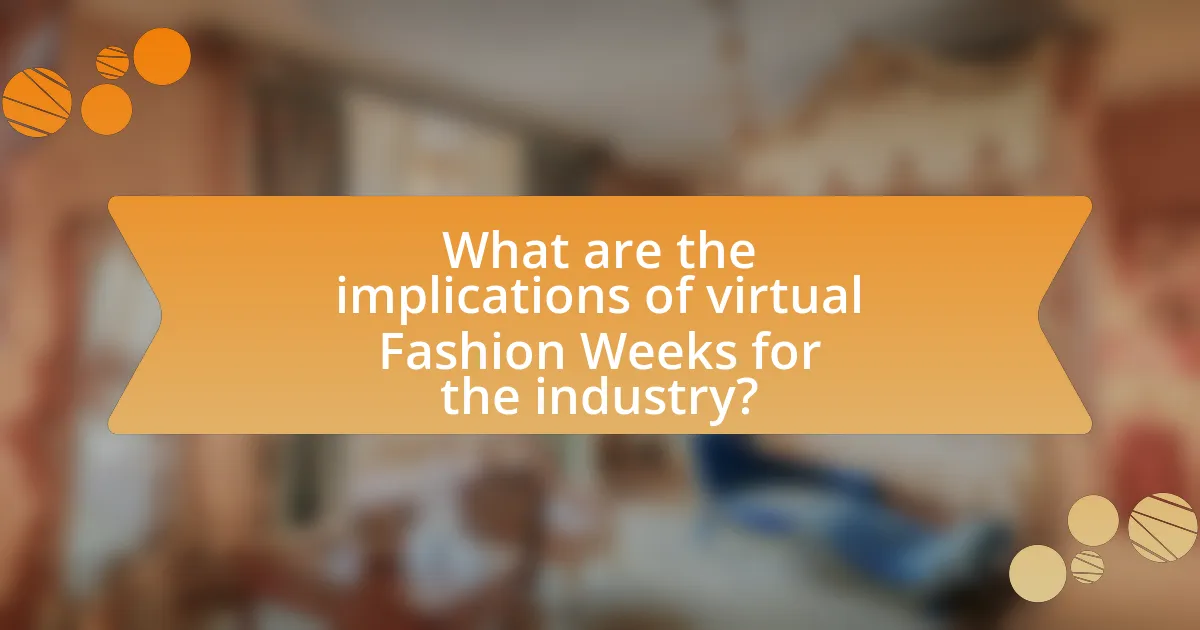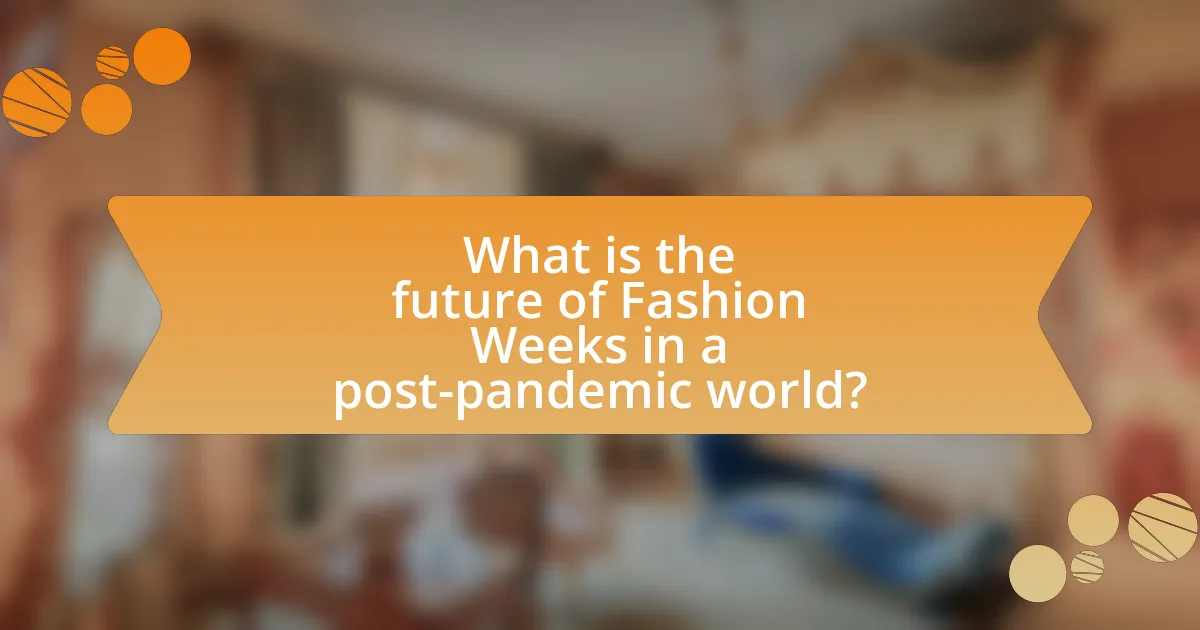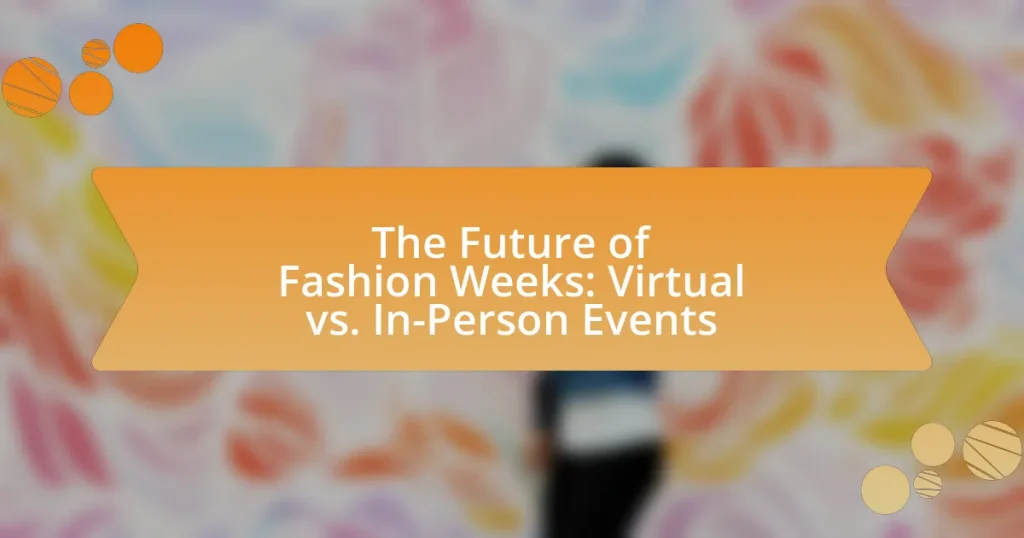The article examines the evolving landscape of Fashion Weeks, focusing on the shift between virtual and in-person events. It highlights current trends such as the rise of digital presentations, sustainability initiatives, and the impact of technological advancements on audience engagement. The discussion includes the historical context of Fashion Weeks, the advantages and challenges of virtual formats, and the implications for designers and brands. Additionally, it explores hybrid models that combine both formats, emphasizing best practices for participation in future Fashion Weeks.

What are the current trends in Fashion Weeks?
Current trends in Fashion Weeks include a significant shift towards digital presentations and hybrid formats that combine both virtual and in-person experiences. This trend has been accelerated by the COVID-19 pandemic, which forced many designers to adapt to online platforms for showcasing their collections. For instance, major fashion houses like Balenciaga and Gucci have embraced digital formats, utilizing social media and streaming services to reach wider audiences. Additionally, sustainability has become a focal point, with brands increasingly prioritizing eco-friendly practices in their collections and presentations. According to a report by McKinsey & Company, 67% of fashion executives believe that sustainability will be a key driver of change in the industry.
How have Fashion Weeks evolved over the years?
Fashion Weeks have evolved significantly over the years, transitioning from exclusive, in-person events to more inclusive, digitally accessible platforms. Initially, Fashion Weeks were primarily held in major cities like Paris, Milan, New York, and London, showcasing collections to a select audience of buyers and press. However, the rise of digital technology and social media has transformed these events, allowing designers to reach global audiences through live streaming and online presentations. For instance, during the COVID-19 pandemic in 2020, many Fashion Weeks adopted virtual formats, enabling broader participation and engagement. This shift has led to a more democratized approach in the fashion industry, where consumers can directly access runway shows and interact with brands online, reflecting a significant change in how fashion is presented and consumed.
What historical events influenced the format of Fashion Weeks?
The format of Fashion Weeks has been influenced by several historical events, notably the rise of ready-to-wear fashion in the mid-20th century and the establishment of the first official Fashion Week in New York in 1943. The introduction of ready-to-wear collections allowed designers to reach a broader audience, shifting the focus from exclusive haute couture shows to more accessible presentations. Additionally, the impact of globalization and technological advancements in the late 20th and early 21st centuries further transformed Fashion Weeks, enabling live streaming and digital showcases, which expanded the reach and format of these events.
How have technological advancements impacted Fashion Weeks?
Technological advancements have significantly transformed Fashion Weeks by enabling virtual events and enhancing audience engagement. The rise of live streaming and social media platforms has allowed designers to reach global audiences, increasing visibility and accessibility. For instance, during the COVID-19 pandemic, many Fashion Weeks transitioned to digital formats, with brands like Balenciaga and Gucci showcasing their collections online, resulting in millions of views and interactions. Additionally, technologies such as augmented reality (AR) and virtual reality (VR) have been integrated into presentations, allowing viewers to experience collections in immersive ways. This shift not only broadens the reach of Fashion Weeks but also alters traditional business models, as brands can now engage directly with consumers and gather real-time feedback.
What are the key differences between virtual and in-person Fashion Weeks?
Virtual Fashion Weeks primarily utilize digital platforms for presentations, while in-person Fashion Weeks involve physical gatherings where designers showcase their collections live. The key differences include accessibility, as virtual events can reach a global audience without geographical limitations, whereas in-person events are restricted to attendees present at the venue. Additionally, virtual Fashion Weeks often rely on pre-recorded content and live streaming, which can enhance production quality but may lack the immediate audience interaction found in live shows. In-person events foster networking opportunities and a tangible experience of fashion, which can be crucial for industry relationships. These distinctions highlight how each format caters to different audience needs and industry dynamics.
What are the advantages of virtual Fashion Weeks?
Virtual Fashion Weeks offer several advantages, including increased accessibility, cost-effectiveness, and enhanced global reach. Accessibility is improved as virtual formats allow audiences from around the world to participate without the need for travel, which can be expensive and time-consuming. Cost-effectiveness is evident as brands can save on venue rentals, logistics, and other expenses associated with physical events. Enhanced global reach is achieved through online platforms, enabling designers to showcase their collections to a broader audience, including potential buyers and influencers who may not attend in-person events. These factors collectively contribute to a more inclusive and efficient fashion industry.
What are the challenges faced by virtual Fashion Weeks?
Virtual Fashion Weeks face several challenges, including technological limitations, audience engagement, and brand representation. Technological limitations can hinder the quality of presentations, as issues like connectivity and platform reliability may disrupt the viewing experience. Audience engagement is another significant challenge, as virtual formats often struggle to replicate the immersive atmosphere of in-person events, leading to lower viewer retention and interaction. Additionally, brand representation can be compromised; designers may find it difficult to convey the tactile and experiential aspects of their collections through a screen, which can diminish the impact of their work. These challenges highlight the complexities of transitioning traditional fashion showcases into a digital format.
How do in-person Fashion Weeks compare to virtual events?
In-person Fashion Weeks offer a tangible experience that fosters direct interaction among designers, models, and attendees, while virtual events provide accessibility and broader reach through online platforms. The physical presence at in-person events allows for immediate feedback, networking opportunities, and a sensory experience of the fashion showcased, which is often lost in virtual formats. For instance, the New York Fashion Week in 2020 saw a significant decline in attendance due to the pandemic, yet virtual presentations allowed designers to reach millions online, demonstrating the contrasting benefits of each format.
What unique experiences do in-person Fashion Weeks offer?
In-person Fashion Weeks offer unique experiences such as direct engagement with designers, live runway shows, and networking opportunities that cannot be replicated in virtual formats. Attendees can witness the craftsmanship and details of garments up close, experience the atmosphere of live performances, and interact with industry professionals face-to-face. These events also foster a sense of community and excitement, as they bring together fashion enthusiasts, influencers, and media in a shared space, enhancing the overall impact of the fashion presentations.
How do in-person events foster networking opportunities?
In-person events foster networking opportunities by providing a physical space for individuals to interact face-to-face, which enhances relationship-building. The direct engagement allows for spontaneous conversations, non-verbal communication, and immediate feedback, all of which are crucial for establishing trust and rapport. Research indicates that 85% of professionals believe in-person meetings are essential for building long-term relationships, highlighting the effectiveness of personal interactions in networking. Additionally, events often include structured networking sessions, workshops, and social gatherings that facilitate connections among attendees, further promoting collaboration and partnership opportunities within the industry.

What are the implications of virtual Fashion Weeks for the industry?
Virtual Fashion Weeks significantly alter the fashion industry by expanding accessibility and reducing costs. These events allow designers to showcase their collections to a global audience without the limitations of physical venues, thus democratizing access to fashion shows. For instance, the 2021 Digital Fashion Week in New York attracted over 1 million viewers online, compared to the limited capacity of traditional shows. Additionally, virtual formats lower production expenses, enabling brands to allocate resources towards sustainability and innovation. The shift also encourages the integration of technology, such as augmented reality, enhancing consumer engagement and interaction with fashion. Overall, virtual Fashion Weeks are reshaping industry dynamics by fostering inclusivity and promoting technological advancements.
How do virtual Fashion Weeks affect designers and brands?
Virtual Fashion Weeks significantly impact designers and brands by expanding their reach and accessibility to global audiences. These events eliminate geographical barriers, allowing designers to showcase their collections to a wider demographic without the constraints of physical attendance. For instance, during the 2021 digital edition of New York Fashion Week, designers reported increased viewership, with some reaching audiences in over 100 countries, compared to traditional shows that typically attract local attendees. Additionally, virtual formats often reduce costs associated with staging physical shows, enabling brands to allocate resources towards digital marketing and e-commerce strategies. This shift has led to a more inclusive environment where emerging designers can gain visibility alongside established brands, fostering innovation and diversity within the fashion industry.
What opportunities do virtual platforms provide for emerging designers?
Virtual platforms provide emerging designers with increased visibility and access to a global audience. These platforms enable designers to showcase their collections without the geographical limitations of traditional fashion weeks, allowing them to reach potential customers, buyers, and industry influencers worldwide. For instance, during the COVID-19 pandemic, many fashion weeks transitioned online, resulting in a 70% increase in viewership for some events, demonstrating the effectiveness of virtual showcases in attracting a broader audience. Additionally, virtual platforms often reduce the costs associated with physical shows, such as venue rental and logistics, making it financially feasible for emerging designers to participate in the fashion industry.
How can brands leverage virtual Fashion Weeks for marketing?
Brands can leverage virtual Fashion Weeks for marketing by utilizing digital platforms to reach a global audience, enhancing engagement through interactive content, and creating immersive experiences. Virtual Fashion Weeks allow brands to showcase their collections to a wider demographic, as they are not limited by geographical constraints. For instance, during the 2021 digital Fashion Week, brands like Balenciaga and Gucci reported increased viewership and engagement metrics compared to traditional events. Additionally, brands can incorporate social media campaigns, live streaming, and influencer partnerships to amplify their reach and create buzz around their collections. This approach not only drives brand awareness but also fosters direct consumer interaction, leading to increased sales opportunities.
What impact do virtual Fashion Weeks have on audience engagement?
Virtual Fashion Weeks significantly enhance audience engagement by providing broader accessibility and interactive experiences. Unlike traditional in-person events, virtual platforms allow global audiences to participate without geographical or financial barriers, leading to increased viewership. For instance, the 2021 Digital Fashion Week in New York reported a 200% increase in online attendance compared to previous physical events. Additionally, features such as live chats, social media integration, and interactive content foster real-time interaction between designers and viewers, further boosting engagement levels. This shift towards virtual formats has been validated by industry reports indicating that brands leveraging digital platforms see higher audience retention and participation rates.
How do virtual events reach a global audience?
Virtual events reach a global audience through online platforms that enable real-time participation from anywhere in the world. These platforms utilize live streaming technology, social media integration, and interactive features such as chat rooms and Q&A sessions, allowing attendees from diverse geographical locations to engage simultaneously. For instance, a study by Eventbrite found that 70% of event organizers reported increased attendance through virtual formats, highlighting the ability to attract a wider audience compared to traditional in-person events. Additionally, the use of targeted digital marketing strategies enhances visibility and accessibility, further expanding the reach of virtual events.
What tools enhance viewer interaction during virtual Fashion Weeks?
Tools that enhance viewer interaction during virtual Fashion Weeks include live streaming platforms, social media integration, and interactive chat features. Live streaming platforms allow real-time viewing of fashion shows, enabling audiences to engage with the content as it unfolds. Social media integration facilitates sharing and commenting, creating a community around the event. Interactive chat features enable viewers to ask questions and participate in discussions, enhancing their overall experience. These tools collectively foster a more immersive and participatory environment, making virtual Fashion Weeks more engaging for audiences.

What is the future of Fashion Weeks in a post-pandemic world?
The future of Fashion Weeks in a post-pandemic world will likely see a hybrid model combining both virtual and in-person events. This shift is driven by the necessity for brands to reach a global audience while also accommodating the growing demand for sustainability and inclusivity in fashion. According to a McKinsey report, 70% of consumers are more likely to engage with brands that offer digital experiences, indicating a strong preference for virtual formats. Additionally, the pandemic has accelerated digital transformation, with many designers successfully showcasing collections online, leading to increased accessibility and reduced environmental impact. As a result, Fashion Weeks are expected to evolve into platforms that blend traditional runway shows with innovative digital experiences, catering to diverse audiences and enhancing brand engagement.
How might Fashion Weeks integrate both virtual and in-person formats?
Fashion Weeks might integrate both virtual and in-person formats by utilizing live streaming technology alongside traditional runway shows. This approach allows designers to reach a global audience, as evidenced by the success of events like New York Fashion Week, which incorporated digital platforms to showcase collections to millions online in 2021. By offering interactive experiences, such as virtual reality showrooms and augmented reality features, attendees can engage with the fashion in real-time, enhancing accessibility and participation. This hybrid model not only expands the reach of Fashion Weeks but also adapts to changing consumer behaviors, as seen in the increasing demand for online content during the pandemic.
What hybrid models are emerging in the Fashion Week landscape?
Emerging hybrid models in the Fashion Week landscape include a combination of virtual and in-person events, allowing brands to reach wider audiences while maintaining the exclusivity of traditional runway shows. For instance, major fashion houses like Balenciaga and Gucci have integrated live-streaming technology into their presentations, enabling global viewers to experience the shows in real-time. This approach not only enhances accessibility but also allows for interactive elements, such as virtual front-row seating and digital showrooms, which cater to both physical attendees and online participants. The success of these models is evidenced by increased viewer engagement metrics and expanded reach, demonstrating a shift towards a more inclusive and versatile fashion presentation format.
How can technology bridge the gap between virtual and in-person experiences?
Technology can bridge the gap between virtual and in-person experiences by enabling immersive interactions through augmented reality (AR) and virtual reality (VR). These technologies allow users to engage with fashion shows and events in a more interactive manner, simulating the in-person experience from remote locations. For instance, brands like Balenciaga and Gucci have utilized AR to let users visualize clothing on themselves through their smartphones, enhancing the shopping experience and making it more personal. Additionally, live streaming platforms can facilitate real-time participation in events, allowing audiences to interact with designers and models, thereby creating a sense of presence similar to attending in person. This integration of technology not only enhances accessibility but also enriches the overall experience, making it more engaging and inclusive.
What are the best practices for participating in Fashion Weeks moving forward?
The best practices for participating in Fashion Weeks moving forward include embracing digital platforms, prioritizing sustainability, and enhancing audience engagement. Digital platforms allow designers to reach a global audience, as evidenced by the increase in online viewership during the pandemic, where virtual shows attracted millions of viewers compared to traditional in-person events. Sustainability is crucial, with brands increasingly adopting eco-friendly materials and practices; a 2021 McKinsey report highlighted that 67% of consumers consider sustainability when making fashion purchases. Lastly, enhancing audience engagement through interactive experiences, such as live Q&A sessions and behind-the-scenes content, can foster a stronger connection with consumers, as seen in successful campaigns by brands like Balenciaga and Gucci.
How can designers prepare for both virtual and in-person events?
Designers can prepare for both virtual and in-person events by developing a cohesive strategy that addresses the unique requirements of each format. This includes creating adaptable designs that can be showcased effectively in both environments, utilizing high-quality digital assets for virtual presentations, and ensuring physical samples are ready for in-person displays. Additionally, designers should invest in technology that enhances virtual experiences, such as 3D modeling and augmented reality, while also planning logistics for physical setups, including venue selection and audience engagement strategies. This dual approach allows designers to maximize their reach and impact across different event formats.
What strategies can brands adopt to maximize their presence in Fashion Weeks?
Brands can maximize their presence in Fashion Weeks by leveraging a combination of strategic partnerships, innovative digital engagement, and targeted marketing campaigns. Strategic partnerships with influencers and media outlets can enhance visibility and credibility, as seen with brands like Balenciaga collaborating with high-profile celebrities to attract attention. Innovative digital engagement, such as live streaming runway shows and utilizing augmented reality experiences, allows brands to reach a broader audience beyond physical attendees, exemplified by brands like Gucci that have successfully integrated technology into their presentations. Targeted marketing campaigns, including social media promotions and exclusive pre-event teasers, can create buzz and anticipation, as demonstrated by the success of brands that effectively utilize platforms like Instagram to engage with their audience prior to the event.



